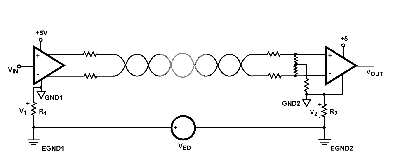Ground loops affect video signals. Understand them, then deal with them. When designing or installing the cables for a video transmission system, one assumption that engineers commonly make is that the local earth grounds of both ends of the cable are the same. When circumstances don’t support this assumption, the video performance can exhibit gross distortions.
Solve ground loop problems in long-distance video transmission article looks at the situations in which ground may have a non-zero potential, and reviews the basic options for grounding connectivity. Finally, it shows a solution that ensures quality video transmission, even when any ground-potential differences are present. This article shows a common-mode compensation for differential transmission lines.

3 Comments
Business Firewall denver says:
This is an epic post, I’ll be sure to add your blog to my list
Tomi Engdahl says:
Home> Analog Design Center > Design Idea
Actively driven ferrite core inductively cancels common-mode voltage
http://www.edn.com/design/analog/4327929/Actively-driven-ferrite-core-inductively-cancels-common-mode-voltage?_mc=NL_EDN_EDT_EDN_designideas_20160216&cid=NL_EDN_EDT_EDN_designideas_20160216&elqTrackId=2f863376557c41c1adf36f5681b0c0bb&elq=1778c7b52b0f4ad695d86c4926d68aa6&elqaid=30825&elqat=1&elqCampaignId=26966
An earlier Design Idea illustrated one approach to that traditional headache for the analog designer: the dreaded ground loop (Reference 1). That Design Idea described a simple and efficient multichannel circuit. But it’s an asymmetrical CMV (common-mode-voltage) approach in that it works only at the receiving end of a cable. It therefore applies only to signal inputs and does nothing for outputs. However, in cases in which CMV consists of purely ac noise, a different CMV-remediation method—active inductive cancellation—works bidirectionally and therefore cancels CMV-error components in both input and output signals.
Engineers have for many years used passive-CMV inductive cancellation (Figure 1). Sometimes called a “humbucker transformer” because the power mains’ 60-Hz “hum” is often a dominant CMV component
However, the Achilles’ heel of the CMV transformer is the fact that the decibels of cancellation fall off at the low-frequency end of the noise spectrum.
In Figure 3, the power amplifier comprising the LT1797 high-frequency op amp and MOSFET forces the driven core to precisely cancel CMV as sensed in the ground-reference connection. The result is such a large multiplication of the apparent winding inductance that you can reduce the “windings” to a simple single pass-through of the toroid core. In other words, you need to thread a multiconductor-signal cable only once through the “hole in the doughnut” to achieve CMV of 40-dB or more cancellation, extending from tens to millions of hertz.
http://m.eet.com/media/1134309/14350-figure_3.pdf
Tomi Engdahl says:
Amplifier cancels common-mode voltage
http://www.edn.com/design/analog/4314195/Amplifier-cancels-common-mode-voltage?_mc=NL_EDN_EDT_EDN_designideas_20160216&cid=NL_EDN_EDT_EDN_designideas_20160216&elqTrackId=994e7e84c4e34f02bfe9b6e0709c50a4&elq=1778c7b52b0f4ad695d86c4926d68aa6&elqaid=30825&elqat=1&elqCampaignId=26966
Since the dawn of time—or at least since the dawn of precision electronics—a major headache for analog designers has been CMV (common-mode-voltage)-induced errors, also known as the dreaded ground loop. Although almost mystical is the fear it strikes in the hearts of engineers, there’s nothing particularly mysterious about CMV. CMV errors occur for a simple reason: The common voltage references—that is, ground—of circuitry in different places, such as sensors in one chassis and an ADC in another, are apt to differ. Therefore, when you route signals between remotely located circuits, the CMV differential appears as additive noise and offset, corrupting the desired signals.
Many approaches exist for eliminating CMV errors. These methods include the brute-force approach of using massive amounts of copper in ground interconnections, fully differential instrumentation-amplifier signal conditioners, and galvanic isolators. Each has its place, depending on such factors as the severity of the CMV problem and the number of signal channels needing CMV remediation. One of the most popular and effective CMV remedies is differential amplification,
The downside of this method is that it requires a dedicated amplifier for every signal channel. The circuit in Figure 1 is a variation on that same differential-amplifier idea, but it combines two shared CMV amplifiers with simple passive-resistor pairs among eight multiplexed channels to provide CMV cancellation for a large number of analog channels at minimum component count.